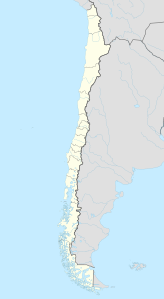Caichinque
| Caichinque volcano | ||
|---|---|---|
|
The north side of the Caichinque volcanic complex. On the right the summit viewed from a distance of approx. 5 km. In the foreground the Salar de Aguas Calientes III . |
||
| height | 4454 m | |
| location |
San Pedro de Atacama |
|
| Mountains | To the | |
| Coordinates | 23 ° 34 '12 " S , 67 ° 26' 24" W | |
|
|
||
| Type | Volcanic complex | |
| Age of the rock | Pleistocene - Holocene | |
|
According to the meaning of its name in the Quechua language, the relatively low mountain appears somewhat lost in the vastness of the flat landscape surrounding it. |
||
|
The satellite image shows the Caichinque volcanic complex in the Altiplano in the middle of a larger depression, which it divides into further sub-depressions due to its presence and in which salars have formed. |
||
The Caichinque is an active volcanic complex in the Andes Western Cordillera near San Pedro de Atacama in northern Chile .
description
The caichinque consists of a conglomerate of stratocones (age: Pleistocene to Holocene ) that rise above a base of rhyodacite ignimbrites (age: Pliocene ).
With a summit height of 4454 m , it is the lowest of the active volcanoes in the central Andes of Chile. It is surrounded by the Salaren Aguas Calientes III in the northeast, Talar in the southeast and Capur in the west, which largely isolate it from the surrounding mountains. The dark, mostly snow-free mountain rises up to 600 meters above the adjacent bright salars.
Of the 90 active volcanoes in Chile, it is one of the least active and dangerous. There has been no eruption in the past 5000 years.
The name Caichinque comes from Quechua and means something like "to be lost" (kay = to be or to be and chinkay = to get lost or get lost.)
Individual evidence
- ^ A b c d Socaire 2368: carta preliminar [material cartográfico]: Instituto Geográfico Militar de Chile. Mapoteca. Biblioteca Nacional Digital de Chile
- ↑ a b Sernageomin, Ranking de los 90 volcanes activos de Chile, 2015 PDF
- ↑ a b c d e Aguilera Sáez, D. (2016). Riesgo volcánico a escala Nacional / Regional: Estudio comparado de variantes metodológicas, para su evaluación y adaptación al contexto volcánico de Chile. ( online )
- ↑ DeSilva, Shanaka L., and Peter W. Francis. Volcanoes of the central Andes. Springer, 1991.
- ↑ González-Ferrán, Oscar. Volcanes de Chile. Instituto Geográfico Militar, 1995. p. 198
- ↑ Gray, Juan. Voces indígenas de uso común en Chile. Vol. 1. Oikos, 2000.



